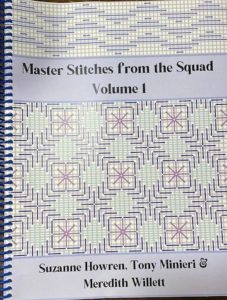
Long & Short Productions, LLC, Falls Church, VA) 2022,
ISBN: 979-80218-01467-4, spiral bound, $90
This book, the first of two planned by the authors, has tons of stitches arranged in categories. The second volume will have the remaining categories. It is compiled from stitches used and developed over the past 13 years of teaching canvas embellishment classes. As a result, the majority of stitches you’ll find in the book are ones you won’t find elsewhere. That’s the strength of the book, but it’s also one of its weaknesses.
A very useful part of the book is the Table of Contents, which really is a sort of index. It lists every stitch in the book under the category where it will be found. The index at the back of the book lists only the categories and sub-categories. It could easily be ignored.
A book like this that’s written by popular teachers with lots of unusual stitches should feel as if you had a teacher looking over your shoulder. For the high cost of the book, the reader should be able to expect some stitching notes or hints. There is some text on the page about starting and ending threads, but otherwise, there is almost nothing. You won’t get ideas about threads to use, places where these stitches work, or even much help on how to make the stitches. Surely with the many classes the trio gives, there must be more to say about the stitches than just the diagrams.
Although the diagrams in the other parts of the book are consistent and understandable, those in the complex stitches section have difficulties. In all cases but one where there are multiple steps, the completed stitch is shown in the large diagram with each step’s stitches shown underneath without a grid. This does not make them immediately understandable but will require the stitcher to study and puzzle out what’s going on. The better approach is shown with only one stitch, where each step of the stitch is shown in a different stitch with the earlier steps still there. Here you can easily see how the stitch is built up.
This is true of only some of the composite stitches. The varying symbols make the steps and components clear on most of the others, but even this is inconsistent. On other stitches, the symbols are so similar that steps cannot be discerned, even with the key. These problems, along with a lack of consistency in diagramming, make this category problematic.
The final category, Jean Hilton Stitches, does not do enough to make these difficult stitches clear. For all but a few of these stitches only numbers on a grid are shown with no explanation. For four stitches lines are shown, but these are all black, so they don’t show how these stitches cross.
Whenever I look at this book, I feel as if I have been cheated a bit by the authors. Like many stitchers, I won’t get to take an in-person class from The Stitch Squad. Like many stitchers, I would like to learn from them. However this book, no matter how different the stitches might be, has little of their knowledge in it. I can understand a “Just the fact ma’am” book and would welcome it, but not for this price. We stitchers have a right to expect more.
About Janet M Perry
Janet Perry is the Internet's leading authority on needlepoint. She designs, teaches and writes, getting raves from her fans for her innovative techniques, extensive knowledge and generous teaching style. A leading writer of stitch guides, she blogs here and lives on an island in the northeast corner of the SF Bay with her family

Leave a Reply